AMD Radeon HD 6870 CrossFireX Performance Analysis
The new AMD Northern Islands graphics cards have been launched to mostly positive reviews. Today we investigate how two Radeon HD 6870 cards will perform in a CrossFireX configuration.
By Kenny Yeo -
Double Trouble
After Evergreen comes Northern Islands, and just last week, AMD released their next generation graphics solution with the Radeon HD 6870 and HD 6850. The two new SKUs powered by the all-new Barts GPU has received high praise from for its compelling combination of performance and price (us included). In fact, the new cards even forced NVIDIA to cut prices of their cards - the GeForce GTX 470 can now be had for around US$259, while the 1GB variants of the GeForce GTX 460 is set to retail for around US$199.
However, the new cards are not perfect and one of the major criticisms leveled at the card was that architecturally, Northern Islands is not all that different from Evergreen, leading some to be dismayed that AMD failed to introduce a revolutionary architecture. Nevertheless, there’s no denying that the new Radeon HD 6800 series cards offer serious graphics firepower for their price, and we are sure that they’ll sell like hot cakes.
And in HardwareZone tradition, we are now following up on our Radeon HD 6800 series review with an analysis on how the Radeon HD 6870 will perform in CrossFireX. AMD claims that performance scaling has been improved and we are hoping to see some dramatic increases in performance.
Our original intention was to present both Radeon HD 6870 and HD 6850 CrossFireX results, but due to some compatibility issues, our two Radeon HD 6850 cards refused to work together. Hence, we’ll be looking at the results from the Radeon HD 6870 and update you in due time once we get the issue of our Radeon HD 6850 cards sorted.
Test Setup
To evaluate how the new Radeon HD 6800 series cards will perform in a 2-way CrossFireX configuration, we’ll be using our trusty X58 setup with the following specifications:
- Intel Core i7-975 (3.33GHz)
- Gigabyte GA-EX58-UD4P motherboard
- 3 x 1GB DDR3-1333 G.Skill memory in triple channel mode
- Seagate 7200.10 200GB SATA hard drive
- Windows 7 Ultimate

The new Radeon HD 6800 series cards are only capable of 2-way CrossFireX so this is as good as it gets.
It goes without saying that the key battle here will be between the Radeon HD 6870 CrossFireX against the 1GB GeForce GTX 460 variant in SLI. Also, it’ll be interesting to see if the new Radeons in CrossFireX can beat a single dual-GPU Radeon HD 5970 and the NVIDIA GeForce GTX 480.
The list of cards tested and driver version used:
- AMD Radeon HD 6870 2-way CrossFireX (Catalyst 10.10)
- AMD Radeon HD 6870 1GB GDDR5 (Catalyst 10.10)
- ASUS EAH6850 DirectCU 1GB GDDR5 (Catalyst 10.10)
- ATI Radeon HD 5970 2GB GDDR5 (Catalyst 10.9)
- NVIDIA GeForce GTX 480 1560MB GDDR5 (ForceWare 260.89)
- NVIDIA GeForce GTX 460 2-way SLI (1GB version - ForceWare 258.80)
- NVIDIA GeForce GTX 460 1GB GDDR5 (ForceWare 258.96)
- NVIDIA GeForce GTX 470 1280MB GDDR5 (ForceWare 258.96)
The list of benchmark used are as follows:
- Futuremark 3DMark Vantage
- Crysis Warhead
- Far Cry 2
- Warhammer: Dawn of War 2
- Battlefield Bad Company 2
- “Heaven" from Unigine v2.1
- S.T.A.L.K.E.R.: Call of Pripyat
Crysis Warhead Results


Far Cry 2 Results


Dawn of War 2 Results

Battlefield Bad Company 2 Results

Unigine Results
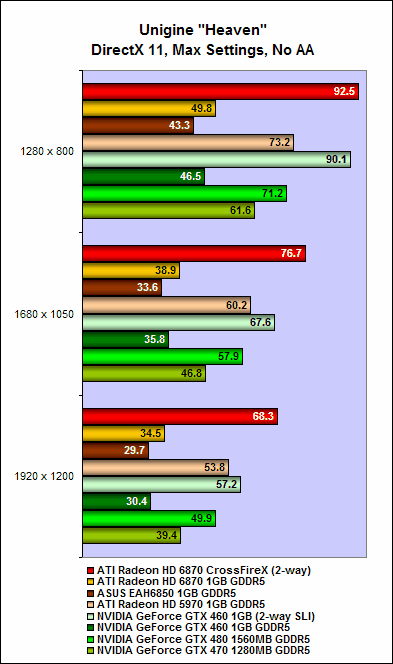 | 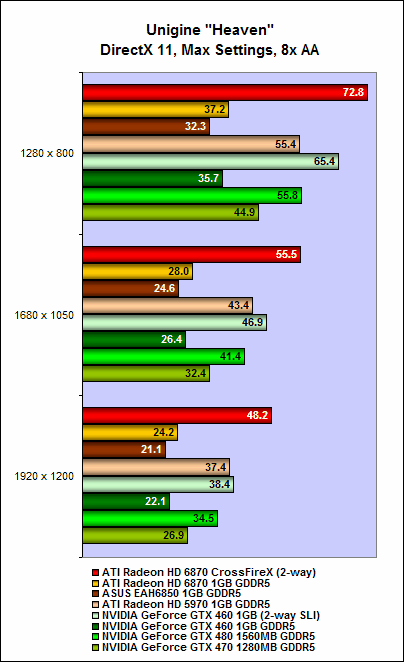 |
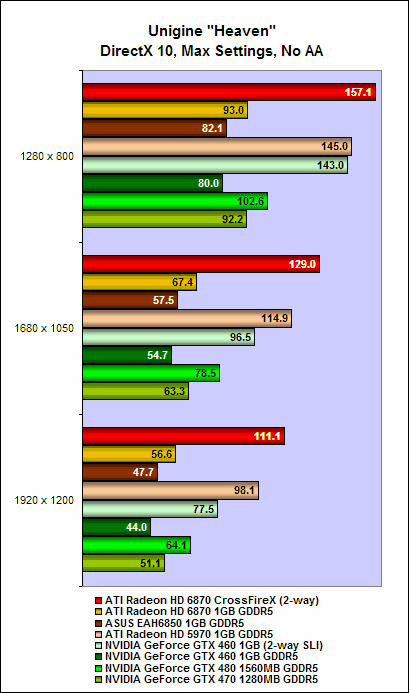 | 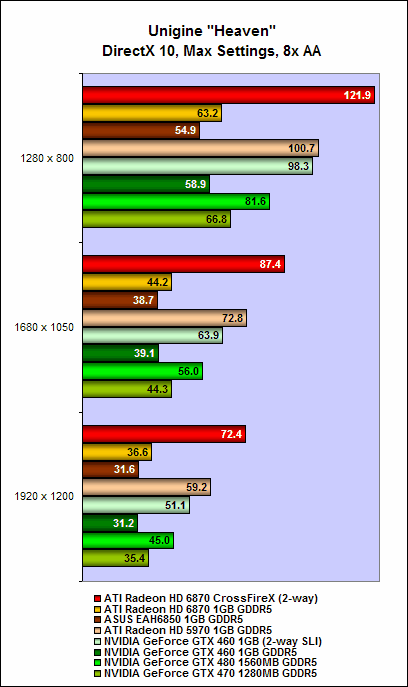 |
S.T.A.L.K.E.R.: Call of Pripyat Results
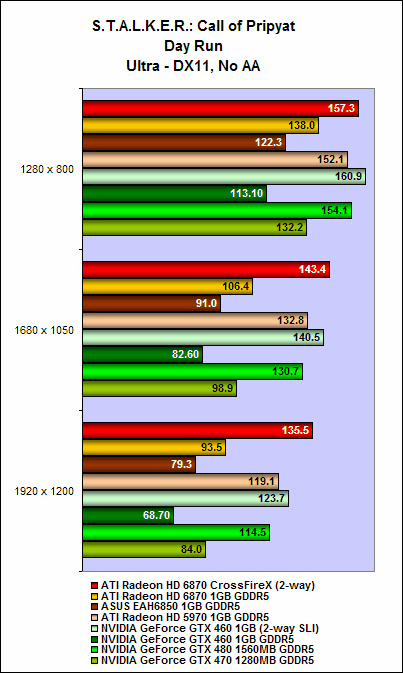 | 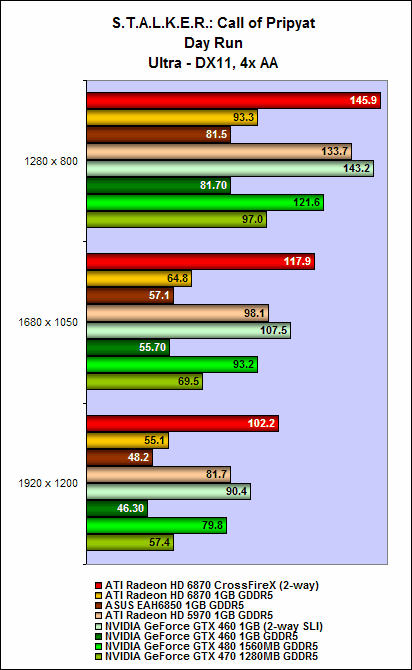 |
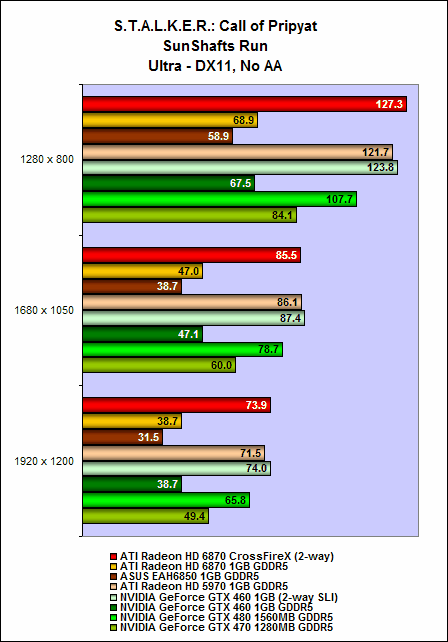 | 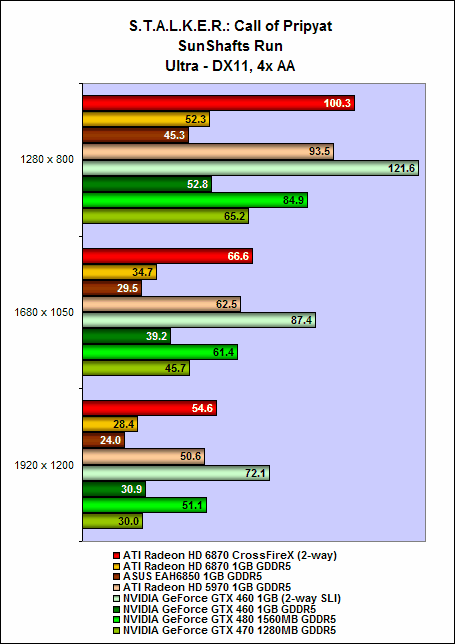 |
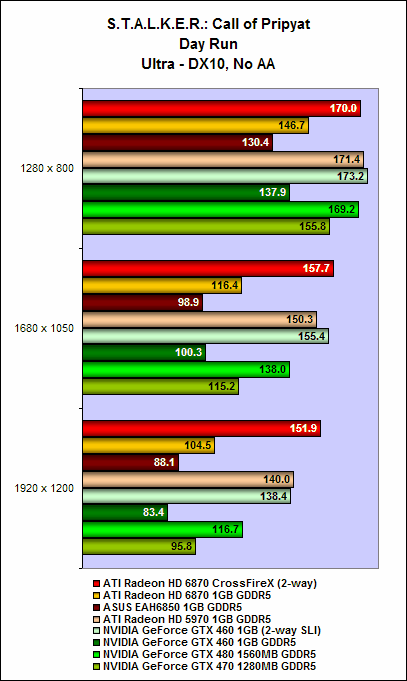 | 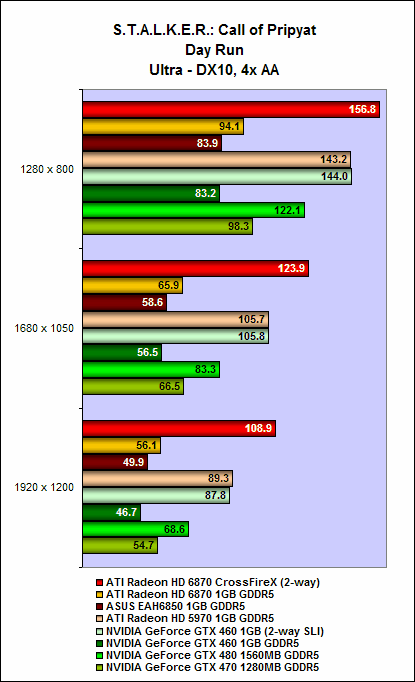 |
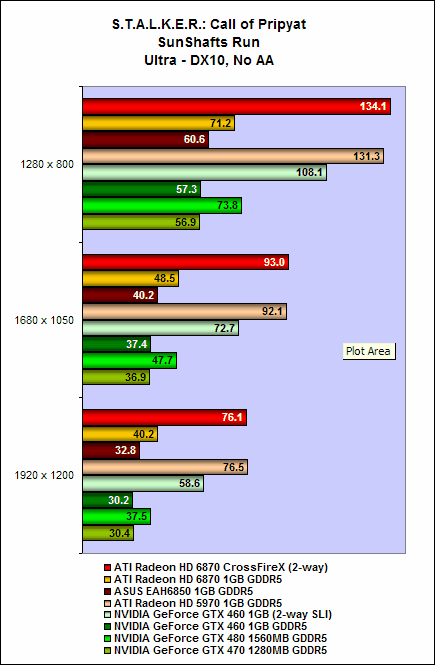 | 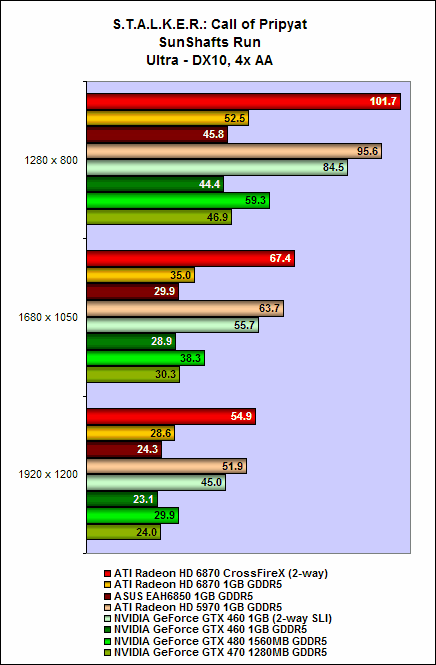 |
Temperature & Power Consumption


Tag Team Power
The new Radeons have received much praise for its performance and taking a look at the results, two Radeon HD 6870 cards in CrossFireX configuration is certainly a potent combination.
It is faster than both the Radeon HD 5970 and GeForce GTX 480, and this was especially so on the more intensive benchmark runs where the two Radeon HD 6870 cards could be as much as 25% quicker than the Radeon HD 5970 and up to 50% quicker than the GeForce GTX 480. And seeing that then Radeon HD 5970 and GeForce GTX 480 both cost around US$500 a piece, a setup consisting of two Radeon HD 6870 cards (at US$460) makes better financial sense.
Against its main rival the 1GB GeForce GTX 460, we saw that two Radeon HD 6870 in CrossFireX is mostly quicker, and by a comfortable margin too. The Radeon HD 6870 really shines when the going gets tough, so in cases such as running Crysis at 1920 x 1200 with 4x anti-aliasing enabled, the pair of Radeon HD 6870 could be as much as 34% quicker than two GeForce GTX 460 in SLI.
The only time where the two Radeons failed to perform was on Battlefield Bad Company 2, where it got really low frame rates, no doubt due to driver issues. These are early days yet and we're sure AMD will rectify this anomaly in due time.

A winning combination - faster than both the Radeon HD 5970 and GeForce GTX 480 and yet less expensive.
On the flip side, with two cards in CrossFireX configuration, power consumption does go up appreciably. Fortunately it is still within manageable limits, and a high quality PSU rated for 550W should more than suffice. More crucially, however, is the issue of heat. A single card running at 75 degrees Celsius is not much of a problem, but when you have two cards running at 75 degrees Celsius, you’d have to begin considering if your setup and chassis is capable of expelling the excess of heat - a casing with excess built up heat can lead to damaged components or shortening of lifespans. Very high capacity hard drives are susceptible to high operating temperatures with high work loads as we've seem our fare share of failures in these situations. As is the case with any multi-GPU setup, we strongly recommend observing that you've dequate ventilation within the casing.
In general, two Radeon HD 6870 in CrossFireX configuration will easily allow you to crunch the latest and most intensive games at the highest resolutions and graphics settings without breaking a sweat. But while power consumption figures remain decent, heat could be an issue especially for more compact casings. Nevertheless, gamers looking to upgrade to AMD’s latest graphics card can rest assure that they can obtain a pretty convincing performance upgrade by just dropping in secondary card sometime down the road.
Looking ahead, we'll be trying to get our pair of Radeon HD 6850 cards to run. But judging from the numbers here, a pair of Radeon HD 6850 should be a fearsome combination too.
Our articles may contain affiliate links. If you buy through these links, we may earn a small commission.